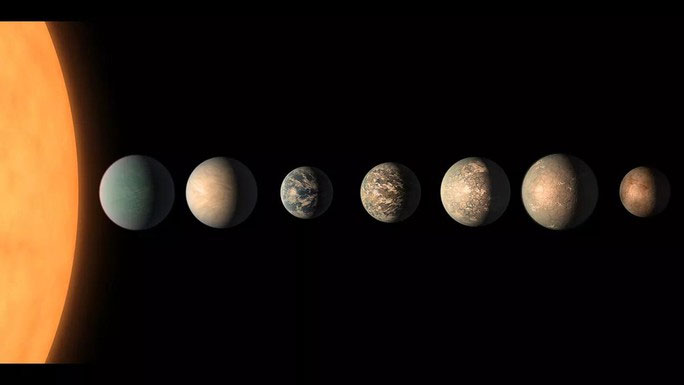New discovery: 7 Earth-like planets that could be habitable
The seven TRAPPIST-1 planets have long been at the center of a lingering controversy, with scientists concerned that certain factors from their parent stars and within the planets themselves could hinder their habitability.
A study recently published in the prestigious scientific journal Nature, led by astronomer Franck Selsis from the University of Bordeaux (France), has brought great news.

Seven "promised lands" for life around the star TRAPPIST-1 - (Photo: NASA).
TRAPPIST-1 is a red dwarf star, much smaller and cooler than the Sun, located just 40 light years away. Its seven planets – varying in size and shape – all share some Earth-like characteristics that could make them suitable for supporting life.
What most interests scientists is that all seven planets have a fairly high potential to harbor liquid water on their surfaces or inside.
But there are hurdles. The strangeness of some of these "ocean planets" has some scientists worried that having too much water compared to Earth would harm life.
The biggest concern remains the parent star: a cool but very radiant red dwarf, with powerful stellar winds that could cause water in its atmosphere to evaporate into space and turn it into a Venus clone instead of an Earth.
But Dr Selsis said red dwarfs like TRAPPIST-1 would decrease in brightness over time.
The model he and his colleagues developed shows that the young TRAPPIST-1 did indeed initially create "hellish" conditions for its seven planets, but as a red dwarf, it would not have been hot enough to melt the crusts and mantles of these magma planets.
This means that quite a bit of water is still trapped in the rocks. That is, the fact that most of these planets are more hydrated than Earth is an unintended advantage.
In the years after the parent star cooled, liquid water oceans could have formed, which could now harbor abundant life.
According to Space , this discovery not only increases confidence in the 7 "promised lands" that have been of interest to astronomers in recent times, but also increases the great opportunity for humans to prove that they are not alone in the Milky Way.
Because red dwarfs like TRAPPIST-1 are the most common type of star in the Milky Way, the galaxy that contains our Earth.
- Discover more than 700 planets outside the solar system
- NASA has found 20 promising planets for human habitation
- Discovered 'Earth materials' in 18 other planetary systems
- Unexpected discovery of 7 planets 'peaceful' than Earth
- Portrait of 'A-Cen Earth' habitable, only 4.37 light-years away
- Discovered the most habitable place in the universe, more than our planet
- Alien life 'hiding' on the moons far from us?
- The Truth About the Solar System's 3rd Habitable Planet
- Discovered two planets that closely resemble the earth
- Discover a set of three planets that may have life
- Where to search for aliens
- 6 habitable planets discovered at the same time
 Van Allen's belt and evidence that the Apollo 11 mission to the Moon was myth
Van Allen's belt and evidence that the Apollo 11 mission to the Moon was myth The levels of civilization in the universe (Kardashev scale)
The levels of civilization in the universe (Kardashev scale) Today Mars, the sun and the Earth are aligned
Today Mars, the sun and the Earth are aligned The Amazon owner announced a secret plan to build a space base for thousands of people
The Amazon owner announced a secret plan to build a space base for thousands of people Chilling discovery of cosmic object that almost brought the Earth to 'apocalypse'
Chilling discovery of cosmic object that almost brought the Earth to 'apocalypse'  Admire 7 planets in the Solar System appearing at the same time in the night sky
Admire 7 planets in the Solar System appearing at the same time in the night sky  Does the Solar System have 5 more planets similar to Earth?
Does the Solar System have 5 more planets similar to Earth?  6 habitable planets discovered at the same time
6 habitable planets discovered at the same time  Strange Phenomenon: Why Are Planets 'Running Away' From the Sun Despite Their Extremely Strong Gravitational Force?
Strange Phenomenon: Why Are Planets 'Running Away' From the Sun Despite Their Extremely Strong Gravitational Force?  In early June, watch 6 planets 'march' in line in the sky
In early June, watch 6 planets 'march' in line in the sky 